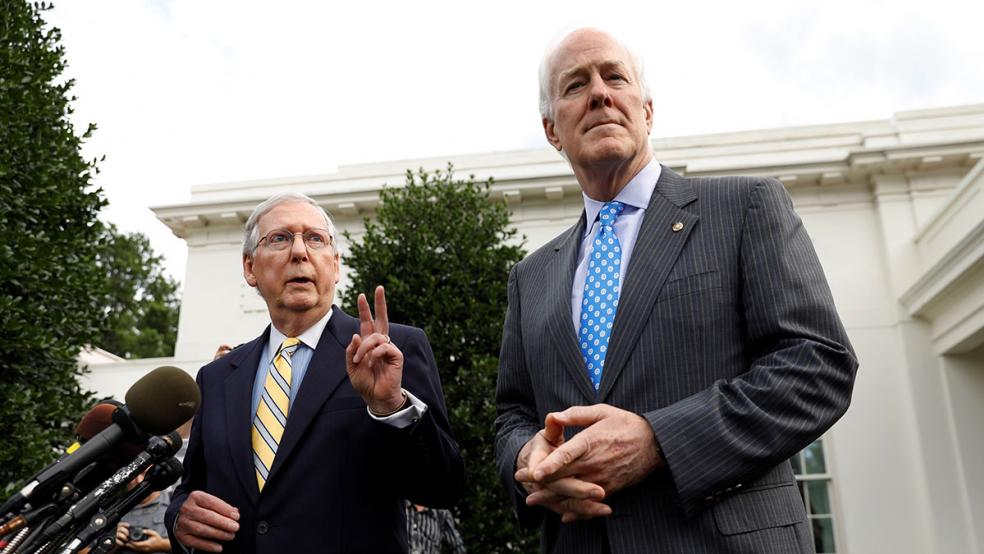As they return from recess, Senate Republicans face the decision of whether to fix their health care plan or let it die. The Better Care Reconciliation Act (BCRA) has received a barrage of media criticism and is not polling well, so the temptation to give up on the bill is strong. But Republicans should stick with it: Their plan makes some very beneficial and underappreciated reforms. By adjusting and effectively marketing the legislation, maybe they can chalk up a political win while improving the nation’s health — both physically and fiscally.
A key benefit of BCRA is that it puts Medicaid on a budget. Right now, the program is growing faster than the overall economy. Over the long run, this is unsustainable. BCRA converts Medicaid from an open-ended entitlement to a per enrollee payment, and it limits the annual growth of this payment after 2025 to the rate of inflation. This reform makes an important contribution to the nation’s long term fiscal health — probably the only one possible under a Trump administration. As the latest update from the Congressional Budget Office shows, the budget deficit will rise sharply in 2017 and is forecast to exceed $1 trillion annually starting in 2022. By 2047, CBO projects a public debt-to-GDP ratio of 150 percent under current law. As Republicans and some Democrats have warned, we are headed for a fiscal train wreck.
Related: Here’s What a Bipartisan Health Care Deal Might Look Like
The four horsemen of America’s fiscal apocalypse are national security, Social Security, Medicare and Medicaid. Under President Trump and Congressional Republicans, spending on defense, homeland security and veteran’s affairs is likely to increase. Social Security and Medicare expenditures are inevitably headed higher due to growth in the eligible population. While Congressional Republicans may wish to reform these programs, Trump opposes any changes. This leaves only one spending driver that can be controlled over the next four or eight years: Medicaid.
As originally drafted, BCRA reduces Medicaid spending by $772 billion over the 10-year budget horizon. Thereafter, the savings continue to grow. By 2036, CBO expects Medicaid spending to be 2.4 percent of GDP under current law and only 1.6 percent of GDP under BCRA. These savings come from both slowing the rate of expenditure growth and rolling back the Affordable Care Act’s Medicaid expansion.
This second change is a major source of controversy and may not be necessary. BCRA reduces federal revenues by $230 billion over 10 years by repealing ACA taxes on wages and investment income for high income earners. If these taxes were kept, more money would be available to continue funding Medicaid expansion while still reducing deficits over the 10-year time horizon. The precise terms of an ongoing Medicaid expansion would have to carefully balance the interests of states that opted into and out of this program under ACA.
Related: Why Medicaid Expansion Could Be Bad News for Poor Americans
Taking the tax repeals out of the legislation removes the Democratic argument that BCRA redistributes wealth from the poor to the rich. That said, there are legitimate arguments for repealing the two taxes (i.e., they punish people for working and investing). But the fate of these Obamacare tax hikes can be decided as part of an overall tax reform package later this year; their repeal need not impact the debate on how we provide health care to disadvantaged populations in a cost-effective way.
Limiting the growth of Medicaid spending over the long-term may provide an impetus toward more cost-effective health care. While Medicaid is less costly than Medicare and private insurance on a per capita basis, it is still very expensive health care by international standards. In 2015, Medicaid spending averaged $7,492 per enrollee. This compares with per capita health expenditures of $4,003 in the United Kingdom, $4,150 in Japan, $4,608 in Canada and $5,267 in Germany. All these countries have higher life expectancies than the U.S., so they appear to be providing adequate care by our standards.
Our system is expensive for a variety reasons. While the Left is correct to remind us that insurance and pharmaceutical company profits contribute to high costs, there are numerous other factors, including (1) high executive compensation at not-for-profit hospitals, (2) huge jury awards in malpractice cases, (3) insufficient use of less expensive non-physician providers such as midwives and nurse practitioners, and (4) unnecessary and redundant tests and procedures.
Related: 7 Huge Tax Breaks in the Senate GOP Health Care Plan
All of these excess cost drivers have support from special interests, and it is hard to imagine Congress removing them — especially during a time-compressed budget reconciliation process. The only feasible option is to put a lid on overall costs and then empower states, providers and patients to implement cost-saving measures.
This is what BCRA does by changing federal Medicaid support to a fixed per enrollee grant. States and providers will no longer have an incentive to maximize reimbursement claims. Instead, they will have to find ways to provide acceptable levels of service within an established cost envelope. BCRA gives states the tools to do this by relaxing restrictions on the Medicaid program.
But I recommend going further. BCRA could give a single health care grant to each state to cover not only Medicaid but also exchange subsidies and assistance for patients that cannot be economically insured due to chronic conditions. Then, the federal government could just leave it up to each state to figure out how to cover residents that lack employer health insurance. Since states are generally required to balance their budgets, their leaders will have an incentive to make cost-saving reforms and to encourage patients and providers to cooperate.
Flexibility can be further enhanced by relaxing ACA’s definition of essential health benefits. This would not only lower the cost of state-provided programs but would also reduce insurance premiums on the exchanges and for employers. While anyone not planning to have a baby should have the option of buying plans without maternity coverage, some essential health benefits would have to remain. In exchange for receiving very large health care block grants, states should be required to cover outpatient and inpatient care as well as prescription drugs.
Related: How the Opioid Crisis Is Damaging the US Economy
States can save money by encouraging patients to use Health Maintenance Organizations like Kaiser Permanente. Kaiser uses a capitated model under which participants pay a fixed cost each year to receive all required services. By keeping patients in network, using electronic health records and sometimes saying no, Kaiser provides care at costs well below the national average.
Blue states might choose to eliminate third parties like Kaiser and instead implement their own single-payer systems. Vermont evaluated single payer a few years ago and decided not to try it, but the California state senate recently passed a single-payer health plan — one that relies on federal funds and can only be implemented with waivers from the Department of Health and Human Services. While I think the California single-payer plan is an awful mistake, maybe we need one or more states to make this error to learn which options work best.
It has been said that states should be laboratories of democracy. Maybe BCRA can become the vehicle by which states become laboratories of cost-effective health care policy.






